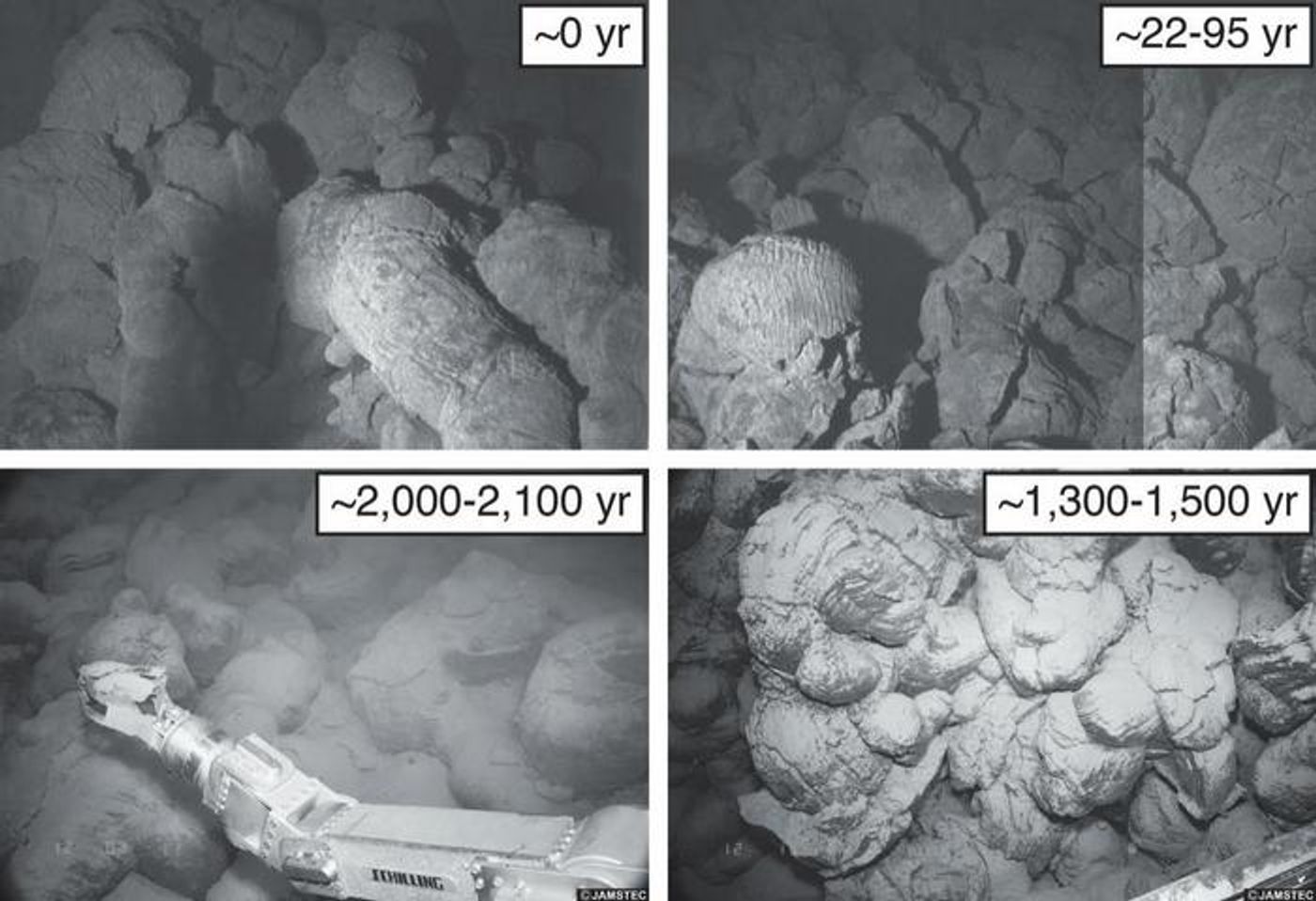The Mysterious Volcanic History of Kamaʻehuakanaloa, A Hawaiian Underwater Volcano
A recent study published in the journal Geology and led by researchers at the University of Hawai’i (UH) examines both recent and past volcanic eruptions from Kamaʻehuakanaloa (aka Kamaʻehu and previously Lōʻihi), which is an underwater volcano located approximately 20 miles off the southern coast of the Big Island of Hawai’i. These findings mark a first-of-its-kind discovery for dating such eruptions and holds the potential to help scientists better understand the various growth stages of Hawaiian volcanoes.
Submersible images of young lavas (top) compared to older sediment-covered lavas (bottom) from Kama'ehu volcano. (Credit: Two bottom images from JAMSTEC)
“Kamaʻehu is the only active and exposed example of a pre-shield Hawaiian volcano,” said Dr. Aaron Pietruszka, who is an associate specialist at the UH Mānoa School of Ocean and Earth Science and Technology (SOEST), and lead author of the study. “On the other Hawaiian volcanoes, this early part of the volcanic history is covered by the great outpouring of lava that occurs during the shield stage. Thus, there is great interest in learning about the growth and evolution of Kama‘ehu.”
For the study, the researchers analyzed the lack of equilibrium, also known as disequilibria, between the radioactive isotopes of radium-226 and thorium-230 to determine the ages of the lava flows from Kamaʻehu. Until now, the only confirmed volcanic eruption at Kama‘ehu happened in 1996, which was only discovered due to remote seismometers located on the Big Island of Hawai’i detecting a series of earthquakes that correlated with volcanic activity at the then-called Lōʻihi volcano.
After earning his PhD from SOEST in 1999, Dr. Pietruszka was a postdoctoral research fellow at the Carnegie Institute of Science, which is where he first began investigating disequilibria in volcanic rocks. Upon returning to SOEST in 2019, Dr. Pietruszka obtained access to data, videos, and images from submersibles examining Kama‘ehu and was successful in finishing the work he started all those years ago.
“The submersible dive images and videos provided independent confirmation of our estimates of eruption ages,” said Dr. Pietruszka. “The lavas with the freshest appearance also had the most radium-226, and vice versa for the lavas with the ‘older’ appearance, that is, fractured and broken, and/or covered with marine sediment.”
Research conducted at Kamaʻehuakanaloa in 2018.
Those estimated ages ranged from the present day to 2,300 years ago, with a minimum of five volcanic eruptions occurring within the last 150 years. These eruptions include a series of changes in volcanic activity and chemistry that occurred between 1,200 and 2,000 years ago. Based on these findings, the researchers ascertained that volcanic activity at Kama‘ehu differs greatly from nearby underwater volcano, Kīlauea.
“I was surprised to discover that Kama’ehu had erupted five times within the last ~150 years, which implies a frequency of ~30 years between eruptions at this volcano,” said Dr. Pietruszka. “This is much slower than at Kīlauea, which erupts almost continuously (with infrequent pauses of only a few years).”
Additional research conducted at Kamaʻehuakanaloa in 2018.
Going forward, the researchers aspire to use these findings to gain greater insights into the formation and evolution of Hawaiian underwater volcanoes located in what's known as the Hawaiian hotspot, specifically pertaining to geologic processes taking place deep underwater.
What new discoveries will researchers make about underwater volcanoes off the coast of Hawai’i in the coming years and decades? Only time will tell, and this is why we science!
As always, keep doing science & keep looking up!
Sources: Geology, EurekAlert!, UH Mānoa SOEST, Hawai’i Center for Volcanology, National Geographic









